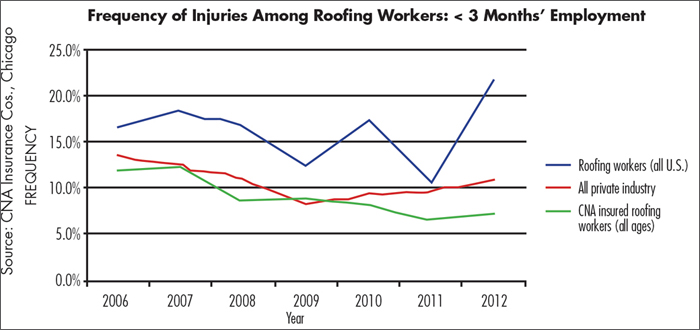The Great Recession experienced in the U.S. from 2007-09 significantly affected the construction industry and many U.S. workers and their families. According to data from the Bureau of Labor Statistics (BLS), more than 25 percent of construction jobs were lost between January 2008 and January 2010.
"We have seen a substantial number of skilled construction workers leave the industry for jobs in other sectors of the economy where they can put their skills to use right away," says John Tatum, senior vice president of CNA Construction, Lancaster, Pa. "For example, with the 'fracking' boom taking place in various shale regions around the country, well-trained crane operators are in high demand in the oil and gas sector."

Figure 1: Number of roofing contractors employed from 2004 to 2014
Specialty construction contractors, including roofing contractors, were not immune to labor market and economic changes. According to BLS, between 2008 and 2010, more than 15 percent of roofing jobs were lost in the U.S. (see Figure 1). As the construction industry recovers and industry demands continue to grow, companies need to offset the losses of labor with new hires. However, hiring new, inexperienced workers to replace the workers lost during the Great Recession has resulted in an uptick in injuries and insurance claims.
A new risk emerges
New employees are more prone to job-site injuries and not only require training about the technical aspects of their jobs, but they also require more safety training. BLS predicts some roofing work may be performed by other construction workers not primarily trained in roofing, and new workers with less experience may enter the roofing job market in years to come.
According to the articles "Risk factors for injury among construction workers at Denver International Airport," American Journal of Industrial Medicine, August 1998 issue, and "Occupational injuries and deaths among younger workers in the U.S.," Morbidity and Mortality Weekly Report, April 2010 issue, newer employees are more prone to workplace injuries, typically during the first year of employment. In addition, the younger the employee, the more at risk he or she may be to job-site injuries because of inexperience.
National data support the sentiment that job experience is related to workplace injuries. Data from BLS show the frequency of injuries among roofing workers with less than three months' job experience increased from 12.3 percent to 21.6 percent from 2009 to 2012. This is in stark contrast to all industries combined in the U.S., including roofing, with injuries only increasing from 8.2 percent to 10.6 percent during the same time period.
Regarding age, the data are not reliable enough to calculate national incident rates; however, absolute counts of injuries among roofing workers younger than 25 appear to remain relatively stable at around 400 injuries since 2009.
CNA claims data
To corroborate national trends in workplace injuries among construction and roofing workers, CNA Insurance Cos., Chicago, conducted an analysis of its claims data.
The report "Impacts of the Great Recession" looks at the effects the gap in experienced workers has had on the construction industry, specifically injury rates on job sites, and it analyzes claims data with the construction industry to help contractors understand the risks their businesses face.

Figure 2: Frequency of roofing worker injuries from 2006 to 2012
CNA claims data indicate 41.2 percent of all construction claims in 2013 involved employees with less than one year of employment. From 2006 to 2009, construction claims frequency involving employees with less than one year of work experience dropped from 51.6 percent to 36.4 percent; however, since post-recovery of the Great Recession, the frequency increased about 4 percent. Since 2009, claim frequency among younger employees remained relatively stable among construction workers.
With respect to roofing workers, the CNA claims data analysis tells a slightly different story. Among those employees with workplace injuries, the frequency of these injuries among employees with less than three months' job experience decreased slightly from 8.7 percent to 6.6 percent from 2009 to 2011. However, from 2011 to 2012, the frequency increased slightly to 7.2 percent. According to CNA claims data, though the overall frequency of roofing injuries was less than the U.S. average, the slight upward trend suggests employees with less than three months' job experience should be closely watched when considering roof safety. Claim frequency among younger roofing workers was not credible enough to yield comparative results.
Overall, CNA claims data among injured roofing workers show less frequency than the national average, but a similar trend between 2011 and 2012 indicates length of employment should be considered as a potential new risk factor for workplace injury.
Be committed to safety
Age and experience may be risk factors for workplace injuries among roofing workers, and it is important for the construction industry and specialty contractors to recognize these risks. National data from BLS corroborated with CNA claims data indicate length of employment may be a significant risk factor for new employees entering the roofing profession.
Although data regarding an employee's age are not reliable, there is a close correlation between age and length of employment as risk factors for workplace injury. Therefore, both risk factors should be considered as the roofing trade recovers from the Great Recession and more roofing workers become employed. This is not to say there aren't other risk factors for roofing workers. Incident type, body part of injury, types of materials handled and other characteristics can increase an employee's risk of injury. When considering age and length of employment, it is important to consider all these factors in combination.
However, it is clear the labor market for roofing workers has changed dramatically since the Great Recession. Contractors will need to find new talent as industry demand continues to grow and a new roofing work force emerges. With this change, roofing contractors also will need to assess the risks of their new employees by understanding these emerging risk factors to prevent job-site injuries.
To prevent workplace injuries among roofing workers, contractors can provide strong employee orientation and training programs to get new employees trained more quickly. The faster a roofing contracting company can get employees working at full capacity safely, the more efficient and cost-effective the organization will become. Roofing contractors who are committed to workplace safety should evaluate these trends and adapt current procedures to curb injuries associated with a worker's age and experience.
Michael Kim, Ph.D., MPH, is a senior analytics consultant for CNA Insurance Cos., Chicago.
The Great Recession: Post-recovery
According to the Bureau of Labor Statistics (BLS), since 2010, the construction industry has realized about a 6 percent increase in all construction jobs. Among roofing professionals, the number of employees has fluctuated since 2010, but there has been a moderate increase in roofing jobs by about 1.2 percent. In 2012, BLS estimated the number of roofing jobs to be 132,700 with an 11 percent growth projected by 2022.
Did you know?
NRCA offers safety classes and DVD-based training programs to keep employees safe and productive, including Serving Up Safety: A Recipe for Avoiding Falls on the Job, a fall-protection compliance program, and Roof Application Training Program: Foundations of Roofing, a program to help train employees in-house about roofing terminology, roof system components, company operations and roof safety. These training programs are ideal for new workers who need to know the basics and existing employees seeking to reinforce their roofing and safety knowledge. For more information, visit shop.nrca.net or contact NRCA's Customer Service Department at (866) ASK-NRCA (275-6722) or info@nrca.net.



